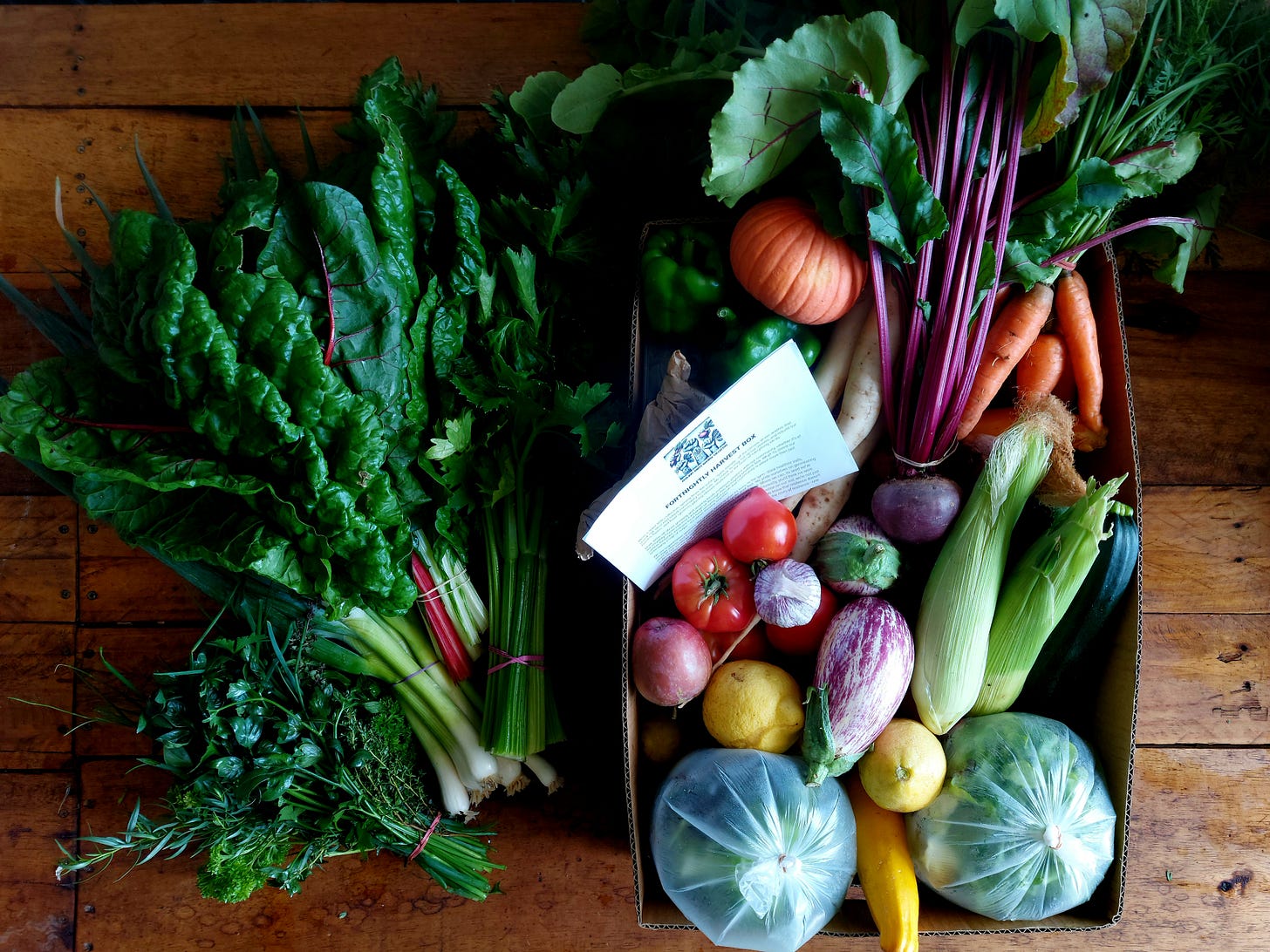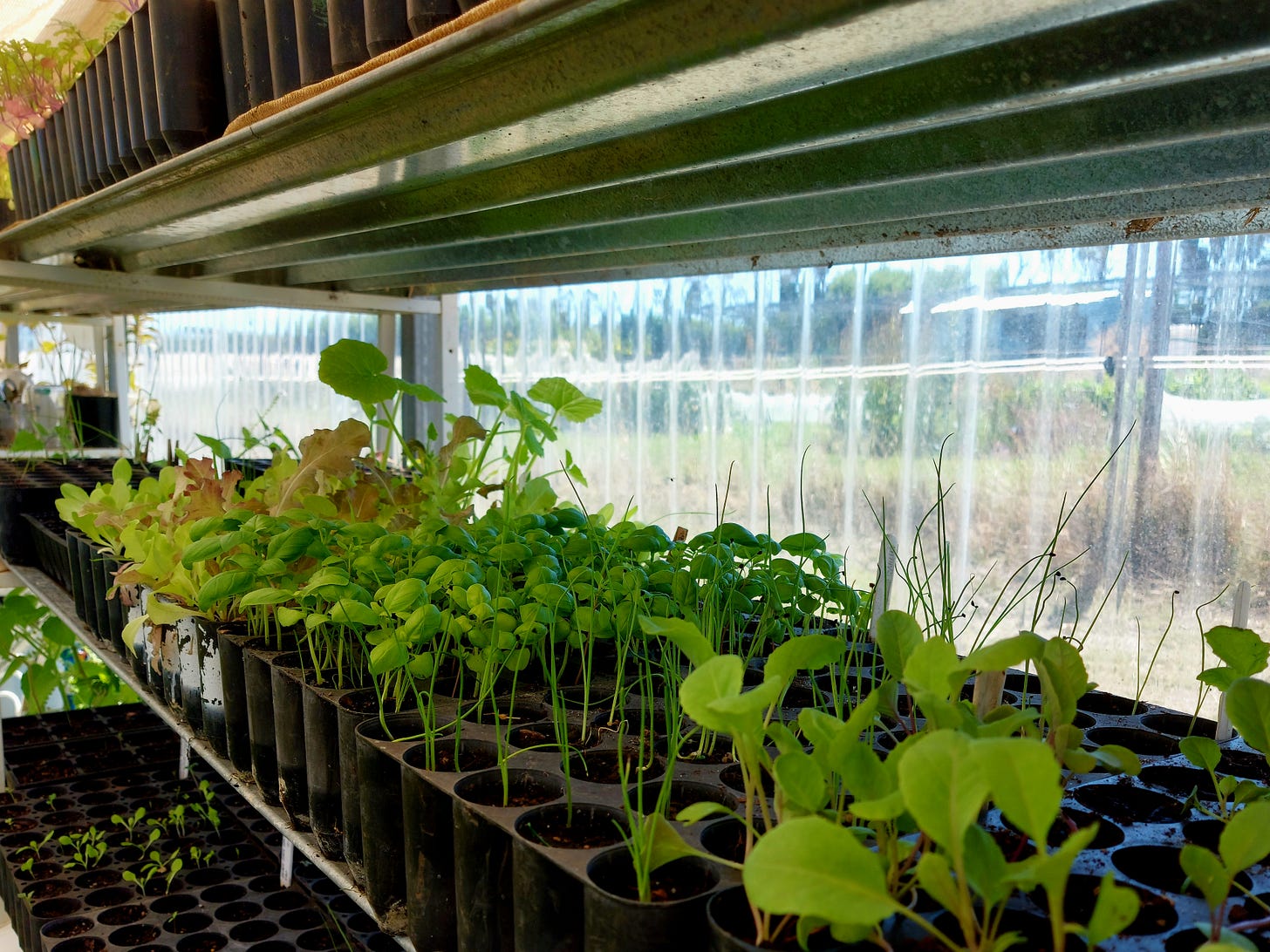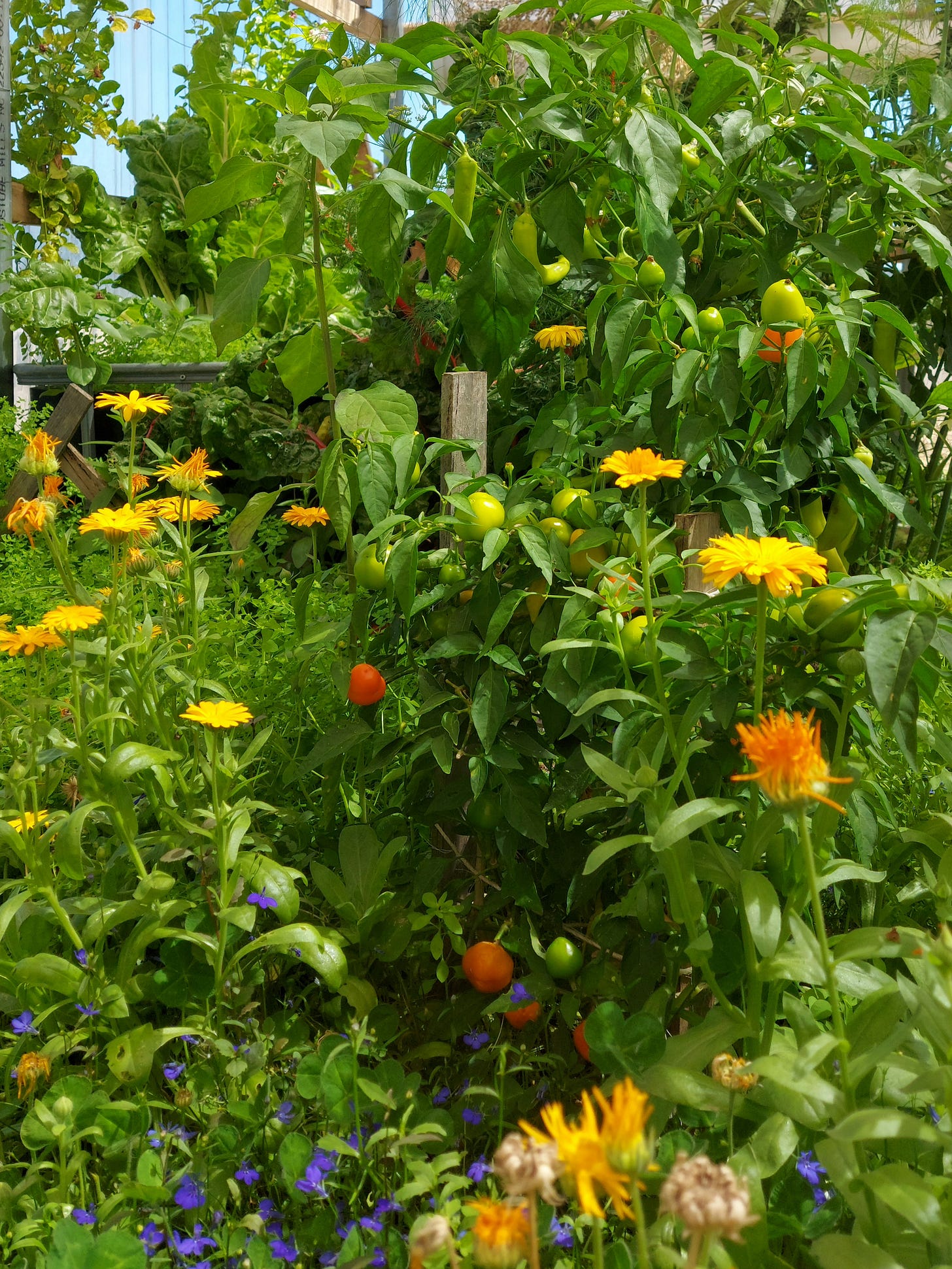Fighting climate collapse isn’t about hashtags; it’s about getting your hands dirty. I've traded social media fake ‘fame’ for real-world resilience, one seedling at a time.
I’m standing in my greenhouse, phone in hand, thumb scrolling. Looking for something—some hook, some angle, something that will make this post ‘land’. My publisher and the PR team want content. The book has launched, and I’m meant to be promoting it. The PR team have asked me for a photo of me ‘growing gorgeous food in the face of tragedy’. WTF! Standing here, in this humid air, surrounded by seedling trays waiting to be watered, I realise something with absolute clarity: This isn’t what I want.
Geoff built this greenhouse, with a shit-tonne of love, for us—to grow food, to rebuild our resilience, to create something real again. Not for me to frame seedlings into aesthetically pleasing shots for an algorithm. The contrast is sickening. The screen in my hand feels like an iron shackle, chaining me to a system I no longer believe in. And right then, the decision lands as solid as the soil beneath my feet: I’m done.
I’ve spent years inside the climate movement, fighting for attention in an ecosystem that rewards outrage over action. I’ve watched organisations pour more energy into self-promotion than solutions. I’ve seen the machine churn through content, turning real, existential threats into viral soundbites—easy to share, easy to forget. Meanwhile, collapse isn’t waiting for the next trending hashtag.
So much of climate activism is just performance. The fight isn’t for change anymore—it’s for airspace. For visibility. The algorithm decides whose truth is heard, and that truth must be packaged, polished, and palatable. The system is rigged by chequebooks, and I’m exhausted from playing by its rules. I want off this merry-go-round.
Some skills, like growing food, don’t just make life easier—they reshape how you navigate it. In behavioural science, these are known as behavioural cusps: not just individual abilities but catalysts for change. One moment, you’re learning something simple, and before you know it, your entire approach to daily life has shifted.
has written a great post about this, Sustainability Sunday: Behavioral Cusps.The key difference between a cusp and any other skill is where it takes you. It’s not just a trick up your sleeve—it’s an entry point. Take learning to light a fire without matches. At first, it’s about the thrill of mastering a survival skill, but soon you’re experimenting with different woods, understanding how they burn, and next thing you know, you’re building an outdoor clay oven. One small skill pulls in another, linking together in ways you never expected.
That’s the magic of a cusp—it’s never just one thing. It’s practical, grounding you in the real world. And once you’ve started down that path, it’s hard to stop. A small step towards resilience quickly becomes a way of life.
For me, climate collapse awareness isn’t about abstract data points—it’s about survival. And survival means real food for people around me. Not a few high-priced crops grown for niche consumers while nutritional gaps remain. Not homesteading food, where one family stockpiles a pantry while their neighbours go hungry. Something in between. Something that actually feeds people. Plural.
And, my greenhouse isn’t just a structure. It’s a threshold. A decision. A commitment. I need to learn how to grow, not just for my home, but for a community.
But first, I had to disconnect from the machine.
Two weeks later, I put the decision into action. On 25 September 2023, I posted this video to Instagram.
Beside the video, I left this note:
It's time to go. I've made a decision. From today, I cease my participation in the social media climate activism bubble.
I am walking away from supporting the many organisations who are really only promoting themselves under a thin veneer of hardcore climate content.
I am not interested in battling the multiple social algorithms that decide whose truth is heard. My ego doesn't need the likes or shares.
Nor do I remain committed to challenging climate hopium addicts who refuse to allow the truth of climate chaos to be heard. Their fear ... it might scare people.
Well, fuck it. People should be shocked and scared, and jolted from their stupor.
Climate collapse is surrounding us all. Many of us have experienced the savage first bites. My own community, and my own life, were brought to our knees by a climate-driven wildfire. I've looked climate chaos in the face and know this is now a game of survival.
I've said my piece. My words are in print. I've written a book. I feel no obligation to do more.
I will remain in contact with my email list. ANYONE WHO WANTS MY SUPPORT walking the urgent and challenging path of CLIMATE ADAPTATION is WELCOME TO REACH ME THROUGH MY NEWSLETTER (link in the bio).
Good luck, everyone. I wish you well.
#climatechange #climatecollapse #climatechaos #climateadaptation
Then I walked away. Shut my accounts. Six months later, I shut down my expensive email newsletter, too (please don’t look for it anywhere. It’s closed). I moved everything to Substack.
Oh boy, was the system mad at me. (Not for the Substack move—that happened after the battle had been fought). The fury came from my refusal to participate. I wasn’t feeding the content machine anymore. No more engagement, no more outrage, no more free labour generating clicks and revenue for platforms profiting from collapse. And that, more than any post, was the ultimate rebellion.
Of course, it came at a cost. Book sales dipped. My ‘profile’ shrank (not that I cared). The offers to write climate change content slowed (I admit, I cared about that a bit more). But something else happened, too: I started sleeping better. My brain, no longer wired for constant reaction, settled. And the greenhouse, once a backdrop for curated social media posts, became something else entirely. What it was meant for.
It was my learning space. My contemplation space. I started lots of growing food. Properly.
Geoff and I had been ‘homesteading’ for years. Not in the Instagram-trad-wife way, but growing, making, and storing a lot of our food. It was part-time, because we had full-time professional careers that took us away, a lot. But what we did taught us self-reliance, the rhythms of growing, the patience of waiting out a season. But it also showed us the limits of isolation. After the wildfire decimated everything and we rebuilt from scratch, Geoff was determined to build me the garden of my dreams. And I had a greenhouse. Oh maird! But standing there, in the two week before I handed my ‘resignation notice’ to social media, surrounded by seedling trays nurtured and ready to go in the ground, it suddenly felt very lonely. All this, just for the two of us? It felt hollow.
So, I searched for the missing something. Over those two weeks, Geoff and I talked, and explored, and brainstormed ideas. I didn’t want a commercial business, but I wanted structure. I wanted to learn how to grow more as if it was a business. So with the registration notice submitted, and my email now deathly quiet, I started studying. I absorbed books and websites. I trialled and tested, failed and won. Slowly unpicking and understanding the methods of market gardening. These remarkable, egregiously under-rated food growers taught me about efficiency, quality, production, and, crucially, how to grow a lot with consistency and regularity—something home gardeners rarely master. My garden and greenhouse took on new meaning, but I still struggled with the collapse angle. Market gardening principles, as brilliant as they are, still produce a few crops en masse, not everything people need to survive.
So I did what I always do: put my feet to the fire. I decided to collaborate and grow, across multiple properties, with the ultimate aim of providing enough fruit and vegetables to feed 12 additional households (between 24 and 30 adults) without them needing to buy other fresh produce, across 12 months of the year. Market gardeners rarely do this. They usually have a down season, so there were new tricks to learn. Of course, I know fruit and vegetables alone are not a whole diet—there is still all the stuff in the pantry to factor, like flour, salt, and vinegar (but I am on to that, too. My first batch of cider vinegar last year worked super well), but it was a start at building real food security beyond my farm gate.
I took a deep dive into crop planning and rotation. Winter growing. Overcoming the hunger gap. Many more beds were created. And a harvest schedule built, and trashed, and built again. That was the biggest curve. How to harvest, wash, and pack a big volume of vegetables and fruit to a fortnightly schedule. All that learning took time, but fifteen months after that post, with two other growers in the Resilient Roots Grower Collective we started supplying Harvest Boxes to four extra households. That might not sound like much, but for me it was a huge achievement. We’re now in our third month and we are reliably, and professionally handing over around 60kg (132 pounds) of fresh, nutritious, organically grown fruit and vegetables every fortnight (for free). In this season, this means carrots (yes, I’ve overcome the possum thief), beetroot, potatoes, leeks, onions, garlic, turnips, radishes, chard, kale, lettuce and rocket, beans, tomatoes, eggplant, courgettes, cucumbers, pumpkin, sweetcorn, pears, apples, peaches, plums, and a huge handful of herbs. Next month we’ll shift to the winter vegetables. Next summer we will expand the volume again. More households will come on board.
My behavioural cusp had taken me to a rich and wonderful space. Those receiving Harvest Boxes now turn up with reciprocal gifts of cow manure, sawdust, chicken food, and glorious hugs. We share a cup of tea in my packing shed, and watch the eagles circling in the sky. We laugh and eat all the plums from their box, before its even made it to the car. We know the next climate chaos shit-storm will come again, soon. But, our community is growing stronger. Our bonds getting deeper. And that’s all I can hope for.
Now, when I stand in the greenhouse, I’m not holding a phone. I’m holding a tray of seedlings, checking their roots, adjusting the moisture, making sure they’re ready to go into the ground. I don’t need to appease an audience. I just need to do the work. This is my way of taking action in the face of climate collapse.
Doomscroll. Delete. Dig.
Solidarity and soil
I walked away from the algorithm’s chokehold to work where it counts: hands in soil, words on the page, shoulder to shoulder with those adapting to climate collapse. This means fire-and-flood writing—scorched, storm-beaten, and stubborn. If this peice moved you, pass it on like a sandbag in rising water. I rely on readers to carry this work to those still trapped in the algorithm’s distortion field.
There’ll be no paywalls, ever—climate collapse is brutal enough. But, if you’ve got coin to spare, become a paid subscriber. Every dime fuels the Resilient Roots Grower Collective, where we’re seeding hard-won knowledge and trial-by-fire systems—because the storm isn’t coming, it’s already here.
This post is part of a Resilient Roots Growers Collective Series with deep gratitude for funding support from the Foundation for Rural & Regional Renewal (FRRR).









Well that's bloody marvellous! Welcome to the soil! (From the damp, slug ridden British stuff) and the sorority of food producers!
This essay was very meaningful to me. Thank you.